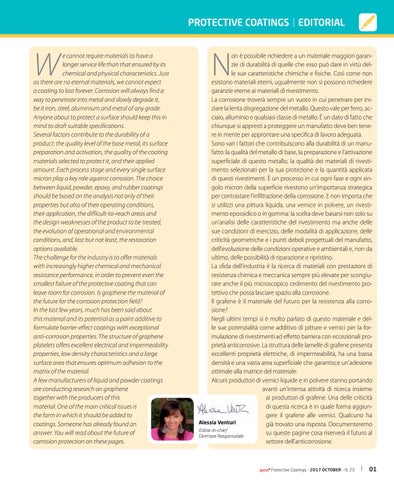PROTECTIVE COATINGS | EDITORIAL
W
e cannot require materials to have a longer service life than that ensured by its chemical and physical characteristics. Just as there are no eternal materials, we cannot expect a coating to last forever. Corrosion will always find a way to penetrate into metal and slowly degrade it, be it iron, steel, aluminium and metal of any grade. Anyone about to protect a surface should keep this in mind to draft suitable specifications. Several factors contribute to the durability of a product: the quality level of the base metal, its surface preparation and activation, the quality of the coating materials selected to protect it, and their applied amount. Each process stage and every single surface micron play a key role against corrosion. The choice between liquid, powder, epoxy, and rubber coatings should be based on the analysis not only of their properties but also of their operating conditions, their application, the difficult-to-reach areas and the design weaknesses of the product to be treated, the evolution of operational and environmental conditions, and, last but not least, the restoration options available. The challenge for the industry is to offer materials with increasingly higher chemical and mechanical resistance performance, in order to prevent even the smallest failure of the protective coating that can leave room for corrosion. Is graphene the material of the future for the corrosion protection field? In the last few years, much has been said about this material and its potential as a paint additive to formulate barrier-effect coatings with exceptional anti-corrosion properties. The structure of graphene platelets offers excellent electrical and impermeability properties, low density characteristics and a large surface area that ensures optimum adhesion to the matrix of the material. A few manufacturers of liquid and powder coatings are conducting research on graphene together with the producers of this material. One of the main critical issues is the form in which it should be added to coatings. Someone has already found an answer. You will read about the future of corrosion protection on these pages.
N
on è possibile richiedere a un materiale maggiori garanzie di durabilità di quelle che esso può dare in virtù delle sue caratteristiche chimiche e fisiche. Così come non esistono materiali eterni, ugualmente non si possono richiedere garanzie eterne ai materiali di rivestimento. La corrosione troverà sempre un vuoto in cui penetrare per iniziare la lenta disgregazione del metallo. Questo vale per ferro, acciaio, alluminio e qualsiasi classe di metallo. È un dato di fatto che chiunque si appresti a proteggere un manufatto deve ben tenere in mente per approntare una specifica di lavoro adeguata. Sono vari i fattori che contribuiscono alla durabilità di un manufatto: la qualità del metallo di base, la preparazione e l’attivazione superficiale di questo metallo, la qualità dei materiali di rivestimento selezionati per la sua protezione e la quantità applicata di questi rivestimenti. È un processo in cui ogni fase e ogni singolo micron della superficie rivestono un’importanza strategica per contrastare l’infiltrazione della corrosione. E non importa che si utilizzi una pittura liquida, una vernice in polvere, un rivestimento epossidico o in gomma: la scelta deve basarsi non solo su un’analisi delle caratteristiche del rivestimento ma anche delle sue condizioni di esercizio, delle modalità di applicazione, delle criticità geometriche e i punti deboli progettuali del manufatto, dell’evoluzione delle condizioni operative e ambientali e, non da ultimo, delle possibilità di riparazione e ripristino. La sfida dell’industria è la ricerca di materiali con prestazioni di resistenza chimica e meccanica sempre più elevate per scongiurare anche il più microscopico cedimento del rivestimento protettivo che possa lasciare spazio alla corrosione. Il grafene è il materiale del futuro per la resistenza alla corrosione? Negli ultimi tempi si è molto parlato di questo materiale e delle sue potenzialità come additivo di pitture e vernici per la formulazione di rivestimenti ad effetto barriera con eccezionali proprietà anticorrosive. La struttura delle lamelle di grafene presenta eccellenti proprietà elettriche, di impermeabilità, ha una bassa densità e una vasta area superficiale che garantisce un’adesione ottimale alla matrice del materiale. Alcuni produttori di vernici liquide e in polvere stanno portando avanti un’intensa attività di ricerca insieme ai produttori di grafene. Una delle criticità di questa ricerca è in quale forma aggiungere il grafene alle vernici. Qualcuno ha Alessia Venturi già trovato una risposta. Documenteremo Editor-in-chief su queste pagine cosa riserverà il futuro al Direttore Responsabile settore dell’anticorrosione.
ipcm® Protective Coatings - 2017 OCTOBER - N. 23
01
